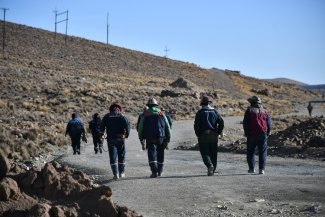Muay Thai (Thai boxing) is the most popular contact sport in Thailand, and a pillar of Thai culture, so much so that for years the Thai government has been asking, unsuccessfully, for it to be included as an Olympic sport. The attraction of this demanding and dangerous form of fighting on canvas is still on the rise among sports enthusiasts. The moral dilemmas associated with it are also on the rise: in mid-November 2018, Anucha Tasakoko, a 13-year-old boy, died of a brain haemorrhage in the ring, in the suburbs of Bangkok.
Despite a law passed in 2003 by the Thai government prohibiting minors from being allowed to risk their health by practising the sport, every weekend hundreds of boys and girls fight professionally to packed stadiums. It is calculated that there are about 200,000 minors who practice Muay Thai in Thailand. On the canvas they are like any other boxer: they are paid and illegal bets on their victories and defeats are the order of the day.

Nine-year-old Nik Phochamrean, doing pull-ups next to his brothers in a gym in one of Bangkok’s working-class suburbs. The boys train two hours a day, six days a week. Thai Sai neighbourhood, Muang district, in the Samutsakhom province, Thailand.
Every year, thousands of foreigners travel to Thailand to learn to master the “art of eight limbs” (two fists, two elbows, two knees and two feet). At a local level, professional boxers are treated as superstars, and amass huge fortunes. There are even university grants for students with a skill for fighting. Many Thai children dream of becoming their idols one day.

Nik (right) and Noey Phochamrean (left), nine and seven years old respectively, do strength-building exercises with weights under the supervision of their trainers. It is calculated that about 200,000 minors practice Muay Thai in Thailand, many of them professionally. Thai Sai Samutsakhom neighbourhood, Thailand.
“If a seven-year-old child is fighting under the same rules and with the same rewards as an adult who weighs 50 kilos more, it means we are failing as a society,” says paediatrician Adisak Plitponkarnpim, director of the Child Safety Promotion and Injury Prevention Research Centre (CSIP) at Ramathibodi Hospital in Bangkok.
Fifteen years ago, this doctor presented the Thai government with a study on the injuries suffered by boxers. “If we have already proved brain damage in adult boxers, what will be the repercussions for a seven-year-old boy by the time he is 12, and still in full growth?” Adisak asked. However, the Thai government ignored the report and rejected any changes in legislation because it did not show negative effects on the health of fighting children.

A pupil at the gymnasium run by Manonut Bonnak, in the suburbs of Bangkok, rests after performing pre-workout warm-up exercises. According to Bonnak, before he began fighting months ago, the boy suffered from epilepsy. “Now he’s perfectly healthy,” says the coach. Thai Sai neighbourhood, Muang district, in the Samutsakhom province, Thailand.
It was then that the paediatrician decided to carry out his own research to prove the brain damage in children who take part in Muay Thai fights. In 2009 Adisak examined 50 child Thai boxers and was able to prove that the children received at least 20 blows to the head every fight.
The next step was to compare the brain scans of 250 children, boxers and non-boxers. For five years, a team of psychologists, neurologists and paediatricians gathered the scientific evidence that corroborated Adisak’s thesis: among the wrestling children alterations were observed in a part of the central nervous system composed of nerve fibres, and changes in memory function could be observed as well as in their IQ. “If we can see this in a few years,” the Thai paediatrician asks, “what consequences will we see when these children are adults?”

Fourteen-year-old Thepsal Malingram receives a direct hit in the head from his opponent, who is four years older than him, which left him unconscious. Recent medical studies have shown memory loss and other impairments in the brains of minors who fight professionally. Bangkok Financial Centre, Thailand.
A few minutes before collapsing, Thepsal Malingram used the little energy he had left trying to reach his opponent’s head with one last kick. He knew that only his height could help him win against an opponent who was four years older than him, but by the second round his body was already battered and had begun to waver. For every blow Thepsal received, hundreds of men shouted from the bleachers out of sheer excitement. Many brandished their betting papers. A strong blow to the chest stopped the boxer and the referee ended the fight.

A mainly male audience at a fight held in a Channel 7 studio in downtown Bangkok. Attendees cover their mouths with papers and use headphones connected to their mobile phones to arrange bets between them. Bangkok Financial Centre, Thailand.
Thepsal is 14 years old and this was not his first fight. Less than an hour ago, in the locker room, while they smeared oil on his body, the boy spoke brave words that actually disguised his sense of impending defeat: “I’m not afraid to get into the ring, but I’m terrified that I’m going to lose.”
More than a decade ago there was an attempt to ban boxing by children in Thailand, but it did not succeed. The only condition stipulated under current law is parental consent for children under 15 (which can also be delegated to the coach) and the use of protection, without specifying what kind. Both parents and fight organisers opposed the law on the grounds that in Thailand there are thousands of families in need of the income that can be earned from child boxing. According to various studies, whether by the US Department of Labor, the National Youth Office or the International Labour Organization (ILO), more than half of the children fight to contribute to their family’s finances.

Thepsal Malingram’s coach and father consoles his son after his defeat on the canvas at the Channel 7 studios, where professional boxing matches with minors are held every Saturday. They both have a seven-hour car drive ahead of them, to get back to their town in the north of the country. Bangkok Financial Centre, Thailand.
Dr. Adisak acknowledges that the majority of the medical community does not support his research. “Most sports doctors have strong ties with Muay Thai and don’t want to hear about regulations,” he laments. Currently he and his team are trying to promote a law that regulates Muay Thai for children. His proposal is simple: “Children under 10 should have no contact when fighting.” The sport is more like a dance and in fact already exists – it is called ‘Muay Thai cream’.

A minor, surrounded by his coaches and his manager, is massaged with special oils that, according to tradition, reduce the inflammation caused by blows received during a fight. Bangkok Financial Centre, Thailand.
“We love Muay Thai. It is part of our culture,” says Adisak. “But if the damage caused by boxing cannot be avoided, we can decide what limits to put on it so that it is not harmful to the younger ones.” The law proposed by the paediatrician is pending approval by the Thai Military Board. “We are hopeful. Perhaps the military will be more effective than the politicians.”











